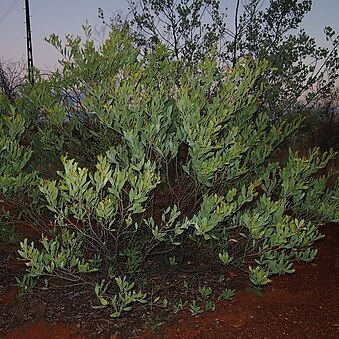Shrub 1–4 (–7.5) m high, ± obconic and commonly spindly. Bark grey. Branchlets minutely appressed-puberulous, the hairs often embedded in resin, the ridges ± resinous-crenulated. Phyllodes mostly obliquely elliptic or narrowly elliptic, 4–12 (–16) cm long, 10–30 (–40) mm wide, rigid, acute to obtuse, minutely ± velvety with hairs not visible to unaided eye, pale bluish green or milky pale green, multistriate, with minor veins numerous (7–9 per mm) and not anastomosing, with 3 or more prominent veins confluent near base. Spikes 2–6 (–7) cm long, orange or golden. Peduncles 1–3 mm long, densely puberulous. Flowers 5-merous, resinous; calyx 0.9–1.2 mm long, dissected for ⅕–½ its length, puberulous; corolla 1.8–2.2 mm long, dissected for c. ½ its length, glabrous; ovary puberulous. Pods linear, almost straight-sided, often curved, ± compressed-terete, 4–13 cm long, crustaceous, pubescent to ± glabrous, resinous, longitudinally furrowed. Seeds longitudinal, narrowly oblong to oblong-elliptic, 3–6 mm long, dark brown; pleurogram with yellowish halo; areole ± open, depressed, olive-brown.
More
A tropical shrub. It grows up to 3 m tall. It has grey or brown smooth bark. The young shoots are covered with woolly hairs. The small branches can be round or angular in cross section. The leaves (phyllodes) are 3-9 cm long and 0.6-3 cm wide. The base of this leaf continues down the stem. The leaf is sharply pointed at the end and leathery in texture. The leaves are flat and yellowish green. They have 4-6 veins which run along the leaf. The flower heads and long (2.5-4 cm) the stalk is hairy. These flowers are bright yellow. The pods are 5-7 cm long and 0.1-0.3 cm across. They are sickle shape and circular in cross section. They are only slightly constricted between the seeds. They are leathery and sticky. The seeds are longer than wide and lie along the pod. They are small, narrow and soft coated.


